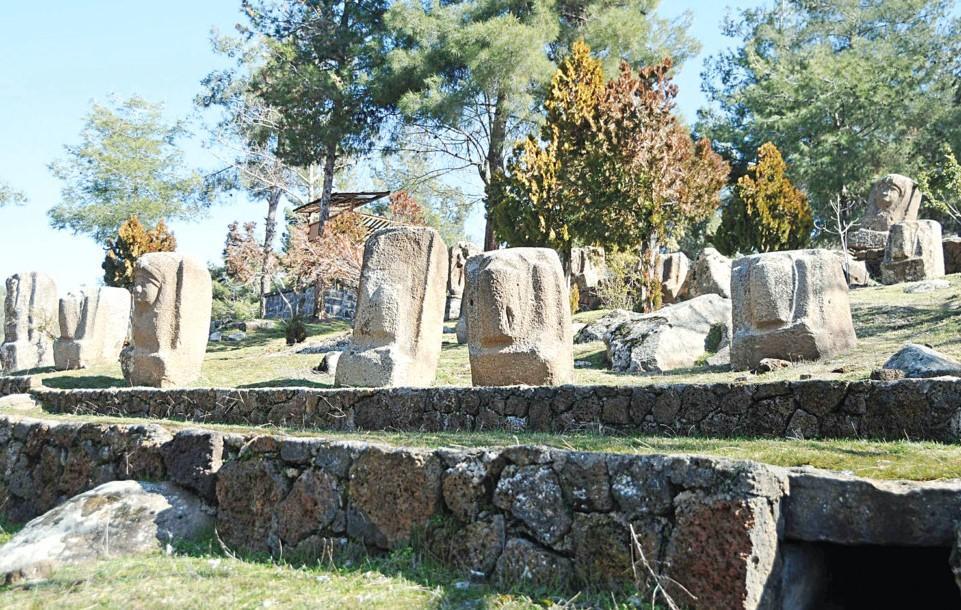Damaged artifacts moved to safe museums
ISTANBUL

The statue of the Hittite King, Suppiluliuma, a symbolic artifact of the Hatay Archeology Museum, survived the earthquake undamaged in the museum, which was partially ruined in the two deadly earthquakes that rattled the country’s south.
Suppiluliuma, who seemed to be trying to understand the earthquake with his surprised and curious eyes, made officials pleased.
The statue of the Hittite King II Suppiluliuma, which marked the ninth century B.C. in the late Hittite period, was unearthed in 2013 during the excavations at the Tell Tayinat mound in Hatay’s Reyhanlı district.
Suppiluliuma, holding a spear in one hand and a Virgo in the other, has become the center of attention of everyone with his big eyes and confused and curious expression on his face. The 1.5-meter-long and 1.5-tons statute, which is made of basalt stone and limestone, is on display at the Hatay Archaeology Museum.
Stating that the museum was not left unattended even for a moment from the first moment of the earthquake, the Culture and Tourism Ministry announced that the restorations of the damaged artifacts have begun.
“Suppiluliuma will meet with visitors as soon as possible,” the ministry said.
No damage occurred to the mosaics in the Hatay Archaeology Museum, which is among the largest mosaic museums in the world. It was reported that there was no problem in the carrier columns of the museum and that the works have been accelerated to reopen the museum.
In line with the emergency action plan after the earthquake, the fastest and most comprehensive personnel reinforcement was made to the Hatay Archaeology Museum. Solar-powered camera systems were installed in the museum to prevent power cuts for security reasons.
Gaziantep, another quake-hit province, is an important city in terms of its historical and cultural heritage. The earthquakes also damaged many historical heritage sites in this city. Many structures that have been restored recently, including the Gaziantep Castle, Şirvani Mosque, Kurtuluş Mosque and Ömeriye Mosque, got ruined.
But the 3,300-year-old sculptures in the Yesemek Open Air Museum and Sculpture Workshop, which is on the UNESCO World Heritage Tentative List, still survive unharmed.
Yesemek neighborhood, 23 kilometers from Islahiye district, has a history of 3,300 years and is located on an area of 110,000 square meters.
In the rural neighborhood, where two houses were destroyed and many houses were damaged by the earthquakes, the museum and the sculpture workshop stay strong.
The Yesemek Open Air Museum and Sculpture Workshop is home to 518 statues made of basalt stone, weighing between 1 and 10 tons, and figures such as lions, mountain gods and chariots.
“The open-air museum covers an area of 110,000 square meters. With this feature, it is the largest open-air sculpture workshop in the world. There are 518 sculptures in this area. Two houses in our village were destroyed and many were damaged during the earthquakes. However, there was no damage to the artifacts in this open-air museum. None of the statues even moved; they remain in place,” said Ali Çiçek, an official at the museum.
Damage assessments of cultural properties in 10 cities have begun. In addition, the Culture Ministry plans to create a cultural road route for Hatay and Antakya and to restore all registered structures - from mosques to synagogues - on these routes.
Against the risk of collapse of the damaged building next to it, some artifacts at the Kahramanmaraş Museum, as well as at the damaged Elbistan Museum, Necmi Asfuroğlu Archaeology Museum and the City Museum in Hatay, have been transferred to safe museums in the surrounding cities.
Also, the Culture Ministry noted that the claims that the handshake column, which was destroyed in the 2,000-year-old Karakuş Tumulus in Adıyaman, has been stolen are not true. It was emphasized that the fallen column was transferred to the Adıyaman Museum and is safe.
















